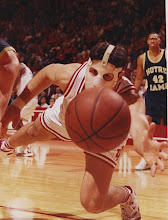The band formed in the late '60s when the members met at Tuskegee Institute in Alabama. Though it is self-titled, this album was the band's fifth studio album, and it proved to be one of their biggest successes, as it was their first platinum seller in the U.S. and their highest-charting album to that point, reaching #3 on the Billboard album chart (their first Top 10 album) and becoming their second #1 album on the Billboard R&B album chart. Oddly, their next two studio albums, 1978's Natural High and 1979's Midnight Magic, would reach the exact same positions on both album charts.
All six of the band's members wrote or co-wrote songs for the album, and the songs range from smooth ballads to straight-up funk. There's no better example of this than two of the band's biggest hits and most recognizable songs that appear on this album -- "Brick House" and "Easy." The former is a funk classic, with drummer Walter Orange handling the lead vocals. The latter is, as the name of the song implies, easy, with Lionel Richie's smooth voice standing in contrast to the lyrics, which are about a guy leaving his woman and not feeling bad about it (hence, he's "easy like Sunday morning"). Both songs were Top 5 hits on the Billboard Hot 100, with "Brick House" going to #5 and "Easy" going to #4. "Easy" also helped to break the band overseas, as it was the band's first Top 10 hit on the UK pop chart and also went to #9 on the New Zealand pop chart.
Though Richie left the band in 1982 to pursue what became a wildly successful solo career, complete with dancing while defying gravity and videos about attractive blind sculptors, the group continued to make music into the early '90s, though their success and popularity seemed to peter off after 1985's Nightshift album and its international hit title track. All in all, between their debut in 1972 and 1986, the band had five Top 10 albums in the U.S., 17 Top 40 hits on the Billboard Hot 100, including ten Top 10 songs and two #1s, and 16 Top 10 hits on the Billboard R&B singles chart, including seven #1s.
Favorite song from Side 1: "Squeeze the Fruit"
The first track off the album is a ball of uptempo funk, with various members taking turns singing.
Favorite song from Side 2: "Patch It Up"
Both "Brick House" and "Easy" are on Side 2, but since I've already talked about them, I'll go with "Patch It Up" because it might be the funkiest song on the album. The bassline is fantastic. If this song doesn't make you bob your head, then chances are, you don't have a head.
Favorite song from Side 2: "Patch It Up"
Both "Brick House" and "Easy" are on Side 2, but since I've already talked about them, I'll go with "Patch It Up" because it might be the funkiest song on the album. The bassline is fantastic. If this song doesn't make you bob your head, then chances are, you don't have a head.














